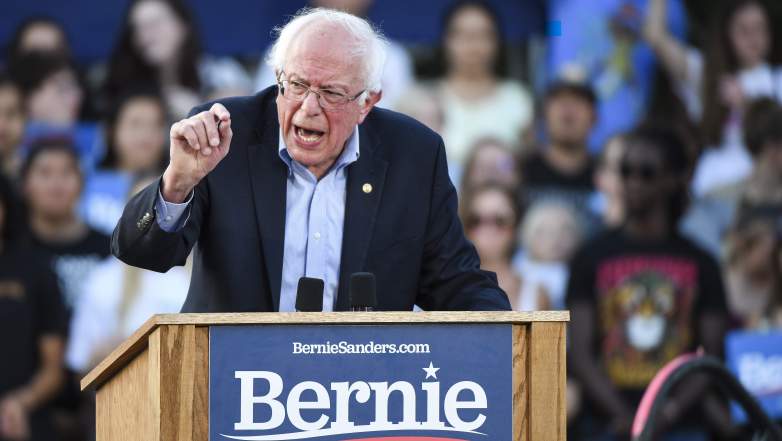
Bernie Sanders was hospitalized on October 1 after the Vermont U.S. Senator and Democratic presidential candidate suffered “chest discomfort” while at a campaign event, according to an October 2 statement from the Sanders campaign. Sanders, 78, is canceling his upcoming campaign events, but is said to be in “good spirits,” after having a procedure done to insert two stents to deal with a blocked artery, the campaign said.
“During a campaign event yesterday evening, Sen. Sanders experienced some chest discomfort. Following medical evaluation and testing he was found to have a blockage in one artery and two sents were successfully inserted. Sen. Sanders is conversing and in good spirits. He will be resting up over the next few days. We are canceling his events and appearances until further notice, and we will continue to provide appropriate updates,” the Sanders campaign said in a statement attributed to senior adviser Jeff Weaver.
Here’s what you need to know:
1. Sanders Went to a Memorial for Victims of the Las Vegas Mass Shooting & a ‘Grassroots’ Campaign Fundraiser Before Being Hospitalized
The 78-year-old Sanders was hospitalized in Las Vegas, Nevada, ABC News reports. He held a public campaign event earlier in the evening there. His next scheduled event was a town hall on medical debt, Medicare for all and Social Security Wednesday morning and a gun safety forum that afternoon, both in Las Vegas.
Sanders visited the Las Vegas Community Healing Garden on Tuesday night on the anniversary of the October 1, 2017, mass shooting.
“The 2020 Democratic presidential hopeful spent a few minutes walking through the garden, where a few other visitors recognized him and shook his hand as he passed. He paused at several victims’ memorials to read the messages placed there,” the Las Vegas Review-Journal wrote.
Sanders attended a “grassroots fundraiser” after leaving the healing garden, according to his campaign.
2. A Stent Is a ‘Tiny Wire Mesh Tube’ Used to Open a Blocked Artery
According to the American Heart Association, a stent is a “tiny wire mesh tube” that “props open an artery and is left there permanently. When a coronary artery (an artery feeding the heart muscle) is narrowed by a buildup of fatty deposits called plaque, it can reduce blood flow. If blood flow is reduced to the heart muscle, chest pain can result.”
The American Health Association adds, “If a clot forms and completely blocks the blood flow to part of the heart muscle, a heart attack results. Stents help coronary arteries open and reduce the chance of a heart attack.”
The stent procedure is minimally invasive. “The doctor will insert a tiny, flexible plastic tube called a catheter through an artery in our groin, leg, or arm. A special dye is injected so blood flow through the arteries is visible on the TV monitors. The doctor moves a balloon catheter, and then a stent, to the site of the blockage. The balloon is inflated and stretched wide against the artery walls, which opens the blockage. Then the balloon is deflated and taken out, leaving the stent in place,” Johns Hopkins Medicine explains.
“An estimated two million people get coronary artery stents every year, and if you have coronary artery disease, there is a good chance your doctor will suggest you get one,” the Harvard Medical School’s Harvard Men’s Health Watch wrote in January 2019. “.If a coronary artery narrows, you may develop symptoms of angina, such as chest pain, shortness of breath, a cold sweat, and lightheadedness. (It’s possible to have a narrowing and no symptoms.)”
Dr. Douglas Drachman, an interventional cardiologist at the Harvard-affiliated Massachusetts General Hospital, told the Harvard website, “”By opening up the blocked artery and restoring blood flow, the stent can stop damage to your heart muscle and reduce your chance of suffering heart failure or even death.”
The medical school site says:
Stent technology has evolved a lot in the past 20 years. Today stents are easier to insert and cause fewer complications and side effects. The mesh is now more flexible and lined with medication to discourage growth of scar tissue and prevent renarrowing of the artery, thus reducing the chance of needing a repeat procedure. About 75% of stents are now inserted through the wrist instead of the groin, which lowers the risk of bleeding and speeds recovery.”
The University of Michigan’s Cardiac Surgery department writes, “After coronary angioplasty, you will be moved to a special care unit, where you will stay for a few hours or overnight. While you recover in this area, you must lie still for a few hours to allow the blood vessels in your arm or groin (upper thigh) to seal completely.”
The site adds, “Most people go home 1 to 2 days after the procedure. Most people recover from angioplasty and return to work about one week after being sent home.”
3. Sanders Was Given a Clean Bill of Health After a Fall in the Shower in February

GettySenator Bernie Sanders.
Sanders would be the oldest U.S. president in history and is one of three 70-plus-year-old Democratic candidates in the 2020 race, along with former Vice President Joe Biden and Senator Elizabeth Warren.
In February, Sanders was treated at a walk-in clinic in South Carolina and received stitches to his head after suffering a minor injury during a fall in the shower. He had a bandage covering the cut on his head at a campaign event after receiving half a dozen stitches. According to The Associated Press, Sanders was given a “clean bill of health” after that incident.
4. Sanders Doctor Said During the 2016 Campaign That the Vermont Senator Was in ‘Overall Very Good Health’

GettySenator Bernie Sanders.
In January 2016, Sanders’ campaign released a note from his physician saying the then-74-year-old was in “overall very good health,” according to the health site Stat News.
The letter from Dr. Brian Monahan, the attending physician at the U.S. Capitol, noted that Sanders had dealt with a variety of medical conditions, including hernia surgery in late 2015 and the removal of “superficial skin tumors,” along with the removal of a cyst from his vocal cord.
Monahan, who has served as Sanders’ physician for more than 26 years, said in the letter that Sanders suffered from gout, which is a form of arthritis, along with a mild case of high cholesterol, diverticulitis and hypothyroidism. Sanders also had laryngitis linked to acid reflux and lower back problems.
“You are in overall very good health and active in your professional work, and recreational lifestyle without limitation,” Monahan wrote.
5. Sanders Said in September That He Would Release Updated Medical Records Ahead of the Democratic Primaries

GettyDemocratic presidential candidate Sen. Bernie Sanders (I-VT) waves to the crowd during a rally at Civic Center Park on September 9, 2019 in Denver, Colorado.
Bernie Sanders said in September that he would release updated medical records ahead of the Democratic presidential primaries, according to The Huffington Post.
“Absolutely. You know, I think it’s the right thing to do. The American people have the right to know about whether the person they are going to be voting for for president is healthy, and we will certainly release our medical records before the primaries,” Sanders told reporters.
According to HuffPost, Sanders said he would have to “get to the doctor” to have a physical and “have a series of tests,” but said he would “certainly” release the information “before the first votes are cast.”
Sanders added, “There’s no reason for me not to release my medical records.”
READ NEXT: Woman Unleashes Vile Racist Rant on Video in CVS in Los Angeles
